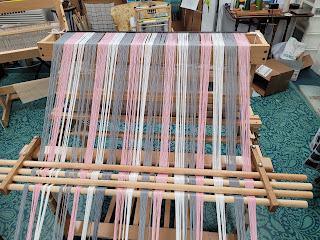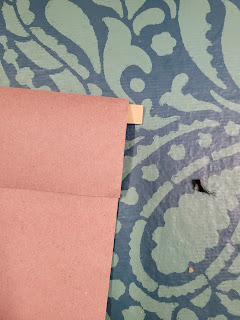It's been ages since did a blog post, but this seemed to be the most logical spot to share how I put a long, wide warp on my loom by myself. I didn't want to blow up everyone's phone with a ton of photos, and also wanted for them to be able to find it later when needed. There are lots of different methods of warping a loom, and are usually contingent upon the type of loom, the fiber content of the warp, the weave structure, the length and width, etc. I'm going to be documenting my baby blanket project that's going on my Louet David loom. So here goes!
First, it's really important to wind a nice warp. Since I'm going to be filling the entire width of my loom, I broke it up into five sections. This makes it a little easier to keep good tension on the warp without tangling. I like to warp by myself because I like to be in control of the tension. Another weaver can be a good helper, but husbands and friends usually aren't able to mind the tension as well as watching and feeling for tangles.
As I wind each section, I put it onto the lease sticks which are hanging off the back of the loom. This is a good chance to check to be sure any color sequences are correct. Getting a middle bout loaded in the wrong direction is a pain in the neck to fix! Keeping your cross is one of the most important elements. I use metal book rings to secure the sticks together and hang them.Once all the warp chains are loaded onto the lease sticks, I insert a bar into the end of the chains and velcro it to my warp bar. This allows you to be able to slide the threads into position without having to deal with the cords that connect the warp bar to the beam. Then I use long shoestrings to tie the lease sticks into position and hold them still.
Next, it's time to load the raddle. My Louet looms all have a built in raddle on top that is approximately 5 sections to the inch. Since it's metric, I just have to leave a space every 4 inches or so to keep the width as planned in inches. Since I'm right handed, I pull threads off the cross for the raddle from right to left. I untie one warp section at a time and let it hang off the front of the loom to give it a little tension, which makes it easier to see the threads in the cross. I have stick-on ruler tape on my loom next to the raddle so that I can see where I am. It also makes it easy to find your starting point when loading the raddle.

Next, it's time to get ready to wind. Since this is a wide warp, I'm going to put in a layer of stick spacers when I begin to wind on. This keeps my threads from being deflected by bumps on the warp beam.
I also use Angel Wings to help keep the warp chains in position with some tension. They aren't totally necessary, but are very handy. My son made these for me, but you can buy them online.
To keep tension on the warp while I'm winding, I stretch the chains across the room and put a weight on them. If you have a carpeted room, books work fine for this. Since I have a hard floor that doesn't get mopped often, I sandwich the chains between cardboard and place weights on top. Be creative!















